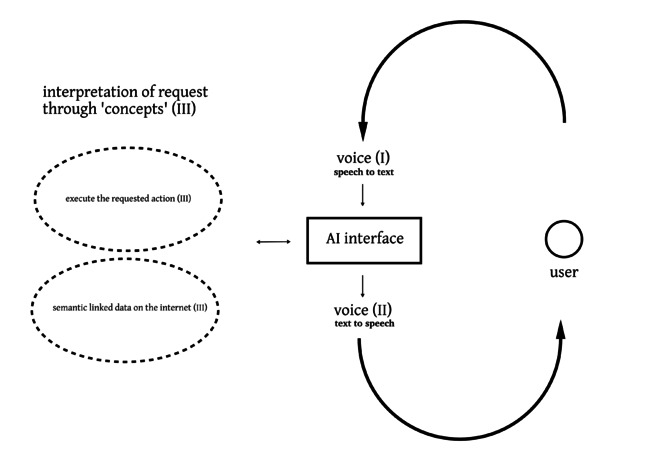User:Manetta/serving-simulations/what-how-why: Difference between revisions
(Created page with "<div style="width:650px;"> * serving simulations (what, how, why - version 01) = serving simulations, film (what...") |
No edit summary |
||
| Line 4: | Line 4: | ||
==# what | ==# what== | ||
'serving simulations' is a film that contains five monologues by artificial intelligence machines. The monoloques are cut-ups from iconic science fiction films, in which the relationship between human and machine is reversed: the machines start to articulate requests to its users, or even instruct them to execute certain actions. By assembling these monologues together, the film tries to highlight a reversed master-servant relationship between humans and AI interfaces. | 'serving simulations' is a film that contains five monologues by artificial intelligence machines. The monoloques are cut-ups from iconic science fiction films, in which the relationship between human and machine is reversed: the machines start to articulate requests to its users, or even instruct them to execute certain actions. By assembling these monologues together, the film tries to highlight a reversed master-servant relationship between humans and AI interfaces. | ||
==# why | ==# why == | ||
In 1995 Brian Massumi already mentioned a blurred boundary between the information requester (the master) and information deliverers (the servants). Who is serving who? Who adjusts himself to who? The user is surely not only the master. Massumi described it as "the human-designed machine designing the human". | In 1995 Brian Massumi already mentioned a blurred boundary between the information requester (the master) and information deliverers (the servants). Who is serving who? Who adjusts himself to who? The user is surely not only the master. Massumi described it as "the human-designed machine designing the human". | ||
| Line 37: | Line 37: | ||
== AI machines as interface == | |||
[[File:Mb-AI-semantic-elements-diagram-page001.png|650px]] | |||
</div> | </div> | ||
Revision as of 16:31, 14 April 2015
* serving simulations (what, how, why - version 01)
serving simulations, film (what, how, why - version 02)
# what
'serving simulations' is a film that contains five monologues by artificial intelligence machines. The monoloques are cut-ups from iconic science fiction films, in which the relationship between human and machine is reversed: the machines start to articulate requests to its users, or even instruct them to execute certain actions. By assembling these monologues together, the film tries to highlight a reversed master-servant relationship between humans and AI interfaces.
# why
In 1995 Brian Massumi already mentioned a blurred boundary between the information requester (the master) and information deliverers (the servants). Who is serving who? Who adjusts himself to who? The user is surely not only the master. Massumi described it as "the human-designed machine designing the human".
These days we have Siri's, Cortana's, Google Now's and Echo's produced by Apple, Microsoft, Google and Amazon. They all interact with their users without any physical interaction: they listen to us, and answer our requests as if they are another human being.
The AI interfaces are build as simulations. They are designed with an attempt to reach a level of intelligence that comes as close as possible to the complexity of human intelligence. The more 'human' an interface seems to be, the more 'intelligent' we name it. This leads to a marketing dialectic of making something that is 'smart', which actually means 'as human-like as possible'. And hence we now live with a range of such 'intelligent' dogged attempts: the Siri's, the Cortana's and the Echo's.
# how
The monologues originate from the following five films: '2001 - a Space Oddysey' (1968), Steven Spielberg's 'AI' (2001), 'Moon' (2009), 'Her' (2013), and Black Mirror's 'Be Right Back' (2013). The cut-ups are made with 'Videogrep', a piece of software (built upon Moviepy and FFmpeg) that makes it possible to search through a film's subtitle file, and select certain 'cuts' according to a search query. The moments in the films where the master-servant relation is turned around, were manually marked with a short lettercode.
(title alternatives)
Master Simulations
Reversed Simulations
Echo Ego
echo ego
echo
echoed simulations
mimicing simulations
mastered models
mastered
mastered simulations

